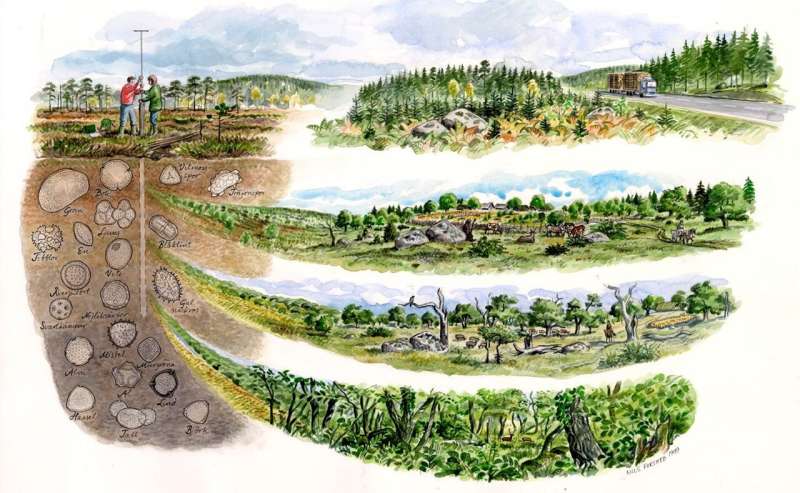This article has been reviewed according to Science X's editorial process and policies. Editors have highlighted the following attributes while ensuring the content's credibility:
fact-checked
trusted source
proofread
Seeing the wood for the trees: How archaeologists use hazelnuts to reconstruct ancient woodlands

If we could stand in a landscape that our Mesolithic ancestors called home, what would we see around us? Scientists have devised a method of analyzing preserved hazelnut shells to tell us whether the microhabitats around archaeological sites were heavily forested or open and pasture-like. This could help us understand not only what a local environment looked like thousands of years ago, but how humans have impacted their habitats over time.
"By analyzing the carbon in hazelnuts recovered from archaeological sites in southern Sweden, from Mesolithic hunter-gatherer campsites through to one of the largest and richest Iron Age settlements in northern Europe, we show that hazelnuts were harvested from progressively more open environments," said Dr. Amy Styring of the University of Oxford, lead author of the article in Frontiers in Environmental Archaeology.
Neolithic Nutella
Humans in northern Europe have been using hazel trees as a source of materials and food for thousands of years. For the people who collected hundreds of hazelnuts found at Mesolithic and Neolithic sites, they were a valuable resource.
"The nuts are an excellent source of energy and protein, and they can be stored for long periods, consumed whole or ground," said Dr. Karl Ljung of Lund University, Sweden, senior author of the article. "The shells could also have been used as a fuel."
Like all plants, hazel trees contain carbon, which exists in different forms known as isotopes. The proportions of the different carbon isotopes are altered by the ratio of carbon dioxide concentrations between leaf cells and in the surrounding environment. In plants like hazel, this ratio is strongly affected by sunlight and water availability; where water is not scarce, as in Sweden, sunlight influences the ratio much more. Where there are fewer other trees to compete for the sunlight and rates of photosynthesis are higher, the hazels will have higher carbon isotope values.
"This means that a hazelnut shell recovered on an archaeological site provides a record of how open the environment was in which it was collected," explained Ljung. "This in turn tells us more about the habitats in which people were foraging."
Gleaning information
To test whether this effect can be seen in archaeological samples, the scientists gathered hazelnuts from trees growing in varying light levels at three locations in southern Sweden, and analyzed the variation in their carbon isotope values and the relationship between these values and the light levels to which the trees were exposed.
They then investigated the carbon isotope values of hazelnut shells from archaeological sites also found in southern Sweden. They selected shell fragments from four Mesolithic sites and eleven sites ranging from the Neolithic to the Iron Age, some of which had been occupied in more than one period.
Using the reference values and the archaeological results, the archaeologists ran a model to assign their hazelnut samples to one of three categories: closed, open, and semi-open. Because the carbon isotopes of an individual hazelnut will naturally vary a little from those of other hazelnuts growing in similar environments, the scientists used multiple samples from each site and assessed the proportion of hazelnuts which had grown in closed or open environments.
Growing changes
The scientists found that nuts from the Mesolithic had been collected from more closed environments, while nuts from more recent periods had been collected in more open environments. By the Iron Age, most of the people who collected the hazelnuts sampled for this study had gathered the nuts from open areas, not woodlands. Their microhabitats had completely changed. This is consistent with environmental reconstructions from pollen analyses, but isotope analysis can be used to visualize a local environment where pollen records are scarce.
"Our study has opened up new potential for directly tying environmental changes to people's foraging activities and reconstructing the microhabitats that they exploited," said Styring.
"We would like to directly radiocarbon-date and measure the carbon isotopes of hazelnut shells from a wider range of archaeological sites and settings. This will provide much more detailed insight into woodlands and landscapes in the past, which will help archaeologists to better understand the impact of people on their environment, and perhaps help us to think differently about woodland use and change today."
More information: Carbon isotope values of hazelnut shells: a new proxy for canopy density, Frontiers in Environmental Archaeology (2024). DOI: 10.3389/fearc.2024.1351411
Provided by Frontiers



















